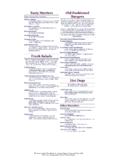Transcription of The sandwich feedback method: Not very tasty - …
1 Journal of Behavioral Studies in Business Volume 7 September, 2014. The sandwich feedback method: Not very tasty C. W. Von Bergen Southeastern Oklahoma State University Martin S. Bressler Southeastern Oklahoma State University Kitty Campbell Southeastern Oklahoma State University ABSTRACT. When correcting employee behavior and providing negative performance comments, managers are often encouraged to begin with something positive and are frequently instructed to use the sandwich method in which one inserts (or sandwiches) criticism between two positive remarks. Although offered by many well-intentioned management trainers and organizations as an effective and humane way for bosses to communicate how badly an employee is doing something, this commonly used method may be undermining both the supervisor's feedback and the relationship with their workers. After reviewing this method of corrective guidance, the authors discuss why leaders use the sandwich approach, the problems presented by this technique, and then offer an effective alternative procedure managers can use to address problematic workplace conduct.
2 Keywords: correcting employee behavior, the sandwich method, employee feedback Copyright statement: Authors retain the copyright to the manuscripts published in AABRI. journals. Please see the AABRI Copyright Policy at The sandwich feedback , page 1. Journal of Behavioral Studies in Business Volume 7 September, 2014. You're one of the best workers I have when you're here; but if you don't improve your attendance in the next two months, I'm going to have to fire you. You've got more talent in your little finger than most people have in their whole body and that's why I'm so worried about you.. When employees do things that are unsafe, unhealthy, unfair, or destructive to the organization, such misconduct cannot be ignored or allowed to continue. According to Trevino (1992), misconduct can be defined from the manager's perspective as any behavior that does not meet work standards according to the prescribed moral or technical requirements.
3 Under this definition, employee theft, drug or alcohol abuse, tardiness, excessive absenteeism or sick leave use, insubordination, and sub-standard work performance may all qualify as misconduct and must be corrected (Redeker, 1984). One very common way that managers are often taught to deal with a worker's poor performance is to apply the sandwich method (Daniels, 2009), also known as the hamburger method of constructive criticism (The Hamburger, 2007) illustrated in the above statement. Managers using this approach to correct problematic employee behavior are instructed to begin with a constructive compliment on something the worker does well (the fluffy bun part) after which they are advised to get to the meat of the matter, which of course is the constructive criticism part. Finally, supervisors are counseled to end with another constructive compliment ( , the other half of the fluffy bun).
4 The intent is to reduce defensiveness, enhance useful communication, and make the input better tolerated by the person receiving the coaching (Nelson & Quick, 2013). Briefly, this approach is illustrated below in Figure 1. Figure 1. The sandwich protocol. COMPLIMENT CRITICISM COMPLIMENT. In using the sandwich technique the supervisor wants to correct some employee bad behavior while simultaneously protecting the worker's self-esteem and increasing the individual's receptivity to changing his or her problematic conduct in the future. This practice often makes the supervisor feel more comfortable because s/he believes they are protecting the worker's ego in bringing up positives while still addressing unwanted or ineffective employee behavior and the negative consequences for its future occurrences which was the point of the conversation to begin with. While the supervisor may feel good because they perceive themselves as being positive and upbeat, the employee, on the other hand, often becomes confused as to what is really happening and the message of the manager regarding the negative employee behavior is diluted.
5 If continued over time, the employee may learn that praise from a supervisor is a prelude to a rebuke from the manager. The reaction to supervisory-initiated positive reinforcement soon becomes, What have I done wrong now? and workers become anxious waiting for something inevitably bad to happen, since the positive comment has become a precursor to criticism. As an unintended consequence, this procedure makes reinforcement less credible at other times. The sandwich feedback , page 2. Journal of Behavioral Studies in Business Volume 7 September, 2014. Sandwiching detracts from the reinforcement value of the positive comments and diminishes the corrective value of the punishing consequences (Daniels, 1989). This article discusses this common managerial error, why leaders use the sandwich approach, and the problems presented by this technique. The authors then provide an alternative procedure managers can use to address problematic workplace conduct.
6 This is followed by a series of guidelines and a conclusion. Why Leaders Use the sandwich Approach There are numerous reasons why managers use the sandwich technique. Schwarz (2013). offered several reasons: first, they think it is easier for people to hear and accept negative feedback when it is sprinkled with positive feedback ; second, they assume the sandwich approach provides balanced feedback ; and third, they believe that giving positive feedback with negative feedback reduces worker discomfort and anxiety . Regrettably, these supervisors simply assume these reasons to be true without any corroborating evidence from the management literature (Daniels, 1989; 2009). Interestingly, when these leaders were asked to query their subordinates on how they preferred to obtain feedback on their job performance, most employees stated that they only wanted the substance (the meat) without the bread the censure without the niceties (Schwarz, 2013)!
7 Another interesting finding was that leaders admitted that they used this particular approach since they find giving negative performance feedback too stressful. Managers found it to be more relaxing by beginning the discussion with the employee by starting first with positive comments. In spite of this, easing in will often produces anxiety rather than preventing anxiety. The lengthier the conversation without providing appropriate corrective feedback , the more uncomfortable managers became. Subordinates sensed their discomfort and then became more anxious and worried. Other reasons why leaders may use the sandwich method surround the issues of optimism and being positive. Managers are encouraged to be upbeat based on two fundamental motivational perspectives: approach and avoidance. Many of the major theorists of motivation and personality have incorporated the approach-avoidance distinction into their conceptualizations (Elliot & Covington, 2001) as fundamental and basic to human functioning.
8 The origin of the approach-avoidance distinction may be traced back to the ancient Greek philosophers Democritus (460-370 ) and Aristippus (435-356 ), who espoused an ethical hedonism that strives to maximize pleasure and avoid pain as the central guide for human behavior. These two perspectives, one approach and the other avoidance, help account for the popularity of the sandwich method. Approach The approach perspective holds that individuals move toward those things they find attractive. (Matlin & Stang (1978), stated that there could possibly be no virtue more enviable in the United States than to be an optimistic and positive person. Researchers such as Judge, Erez, & Bono (1998) and Neck & Manz, (2007) stated that management theorists teachers, theologians, philosophers, counseling and sports psychologists and even well-known self-help experts emphasize the importance of being a positive person in order to be able to achieve productivity, happiness, satisfaction, in addition to personal growth and effectiveness The American way of life is replete with stories emphasizing optimism.)
9 The French philosopher The sandwich feedback , page 3. Journal of Behavioral Studies in Business Volume 7 September, 2014. Alexis de Tocqueville visited the United States in 1831 to determine what made the country so vibrant and successful and noted America's optimism and emphasis on the positive. Perhaps such an emphasis on being positive should come as no surprise since it is a cultural byproduct of a country that placed the right to happiness in its 1776 Declaration of Independence. The cultural tradition of positivity still fuels the American dream in the 21st century (Handy, 2001). Many parents raise their children to see the glass as half-full and to recognize that every cloud has a silver lining. Americans are a positive people cheerful, optimistic, and upbeat: this is their reputation as well as their self-image (Ehrenreich, 2009). Such a positivity zeitgeist has become so ingrained in American society that positive seems to not only be normal but also normative the way a person should be.
10 Thus, it is understandable why managers when correcting poor employee performance want to highlight the positive even as they address a worker's poor conduct. Avoidance The avoidance perspective holds that individuals try to evade that which they find to be undesirable or disagreeable. This is the case with providing subordinates negative feedback . Such feedback , however, presents a dilemma; most believe it necessary but few want to deliver it (Ilgen & Davis, 2000). Apparently, it is so aversive that it is often neglected (Landy & Farr, 1980; Von Bergen, 2012), frequently leading to future, more serious problems. Many supervisors would rather endure a root canal than deliver negative performance feedback where there are some hard, cold truths that they cannot avoid discussing (Kjerulf, 2008). This perspective suggests, once again, why managers may like the sandwich approach with its emphasis on positive aspects of employee behavior while interjecting a few words about problematic behavior.












![WELCOME [www.tastycatering.com]](/cache/preview/e/6/f/4/4/f/f/d/thumb-e6f44ffdce47497fc67b217a43d3e0b6.jpg)



